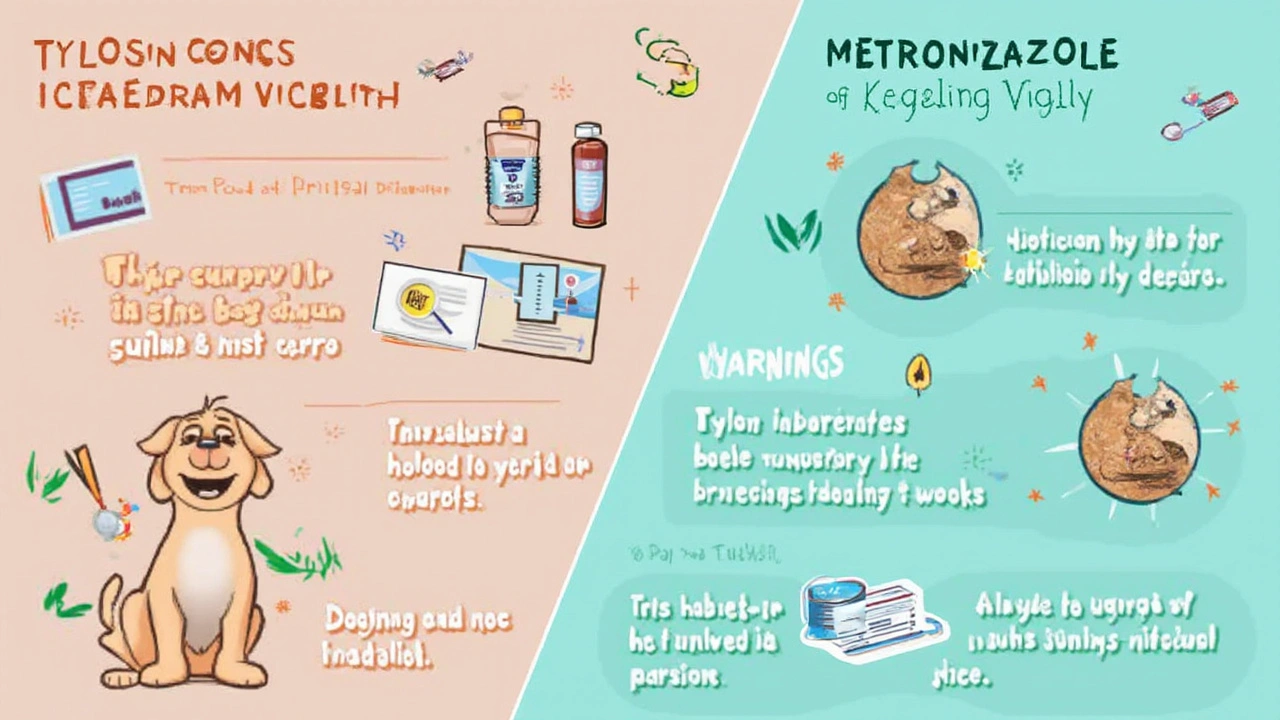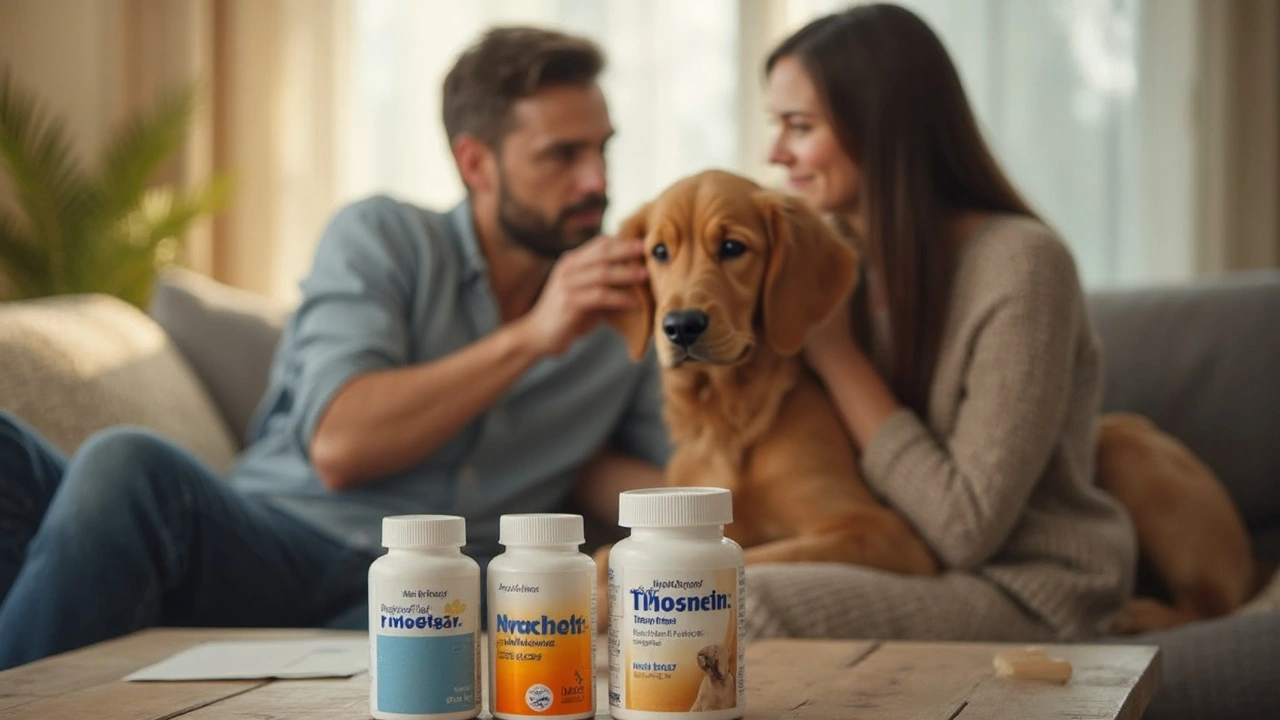Why Antibiotics for Canine Diarrhea Are a Double-Edged Sword
If you’ve spent even a few days with a dog, you know that canine diarrhea can go from a minor mess to a full-on crisis overnight. The first instinct? Find a quick fix. A lot of vets and desperate owners reach for antibiotics as if they’re some sort of magic button. The numbers back this up: a 2023 North American Vet Association survey found that over 60% of canine diarrhea cases in clinics ended up with a prescription for antibiotics. But guess what? Not all diarrhea in dogs needs antibiotics. In fact, abusing or misusing them can land your pup with worse problems.
Why such a fuss? Most cases of canine diarrhea are actually caused by stress, sudden diet changes, or gut bugs that antibiotics can’t touch. Only when a true bacterial infection takes over, or there’s proof of serious inflammation, does hitting the pharmacy make sense. What’s wild is, a Swedish study found dogs given antibiotics for basic diarrhea recovered in about the same time as dogs who had only bland diets and rest. Still, the right antibiotic, in the right situation, can save a dog’s life. But one pill fits all? Not even close. Each major antibiotic—tylosin, amoxicillin, and metronidazole—acts differently in your dog’s system. What works for a Labrador with chronic colitis could be overkill or even dangerous for a nervous Chihuahua with a sensitive belly.
Here’s a clincher: popping random antibiotics can wreck the natural bacteria in your dog’s gut. It’s called dysbiosis, and experts believe it’s why so many dogs get stuck in a diarrhea-relapse cycle. Add in the growing issue of antibiotic resistance, and it’s clear that reaching for a pill every time your dog has a G.I. hiccup isn’t just risky, it’s shooting yourself (and your dog) in the paw for the future.
Tylosin: The Unsung Hero for Chronic and Mystery Diarrhea
Tylosin doesn’t make headlines like amoxicillin, but if you ask experienced vets, they’ll often nudge you toward this old-school antibiotic for stubborn or mysterious cases. Tylosin is a macrolide antibiotic, and it’s got a knack for calming ongoing diarrhea in dogs, especially those diagnosed with something called “antibiotic-responsive diarrhea.” There are dogs out there who’ll have a raging case of the runs every week until you give them tylosin—then boom, solid poop. Researchers at Cornell found that in chronic GI disease, more than half the dogs put on tylosin got significant improvement within days.
What’s really cool is, tylosin isn’t just busting bacteria. Some scientists think it also tweaks the immune response in the gut, which might explain why it often works when other meds fail. It’s especially effective in breeds like German Shepherds, who are notorious for ongoing gut issues. You’ll sometimes hear the label “Tylosin-Responsive Diarrhea” because there’s a definite pattern: chronic runs, other drugs flop, give tylosin, diarrhea disappears. But the effect often only lasts as long as the drug does—stop it, and the squirts can come back. Tylosin is rarely the answer for sudden, bloody diarrhea or clear food poisoning cases.
But, there are downsides. Tylosin isn’t officially FDA-approved for dogs (it’s originally a livestock drug), so you’re always a bit in gray territory. The most common side effect is loose stools (ironic, right?), plus the occasional tummy upset. Give too much, and you might see dogs go off their food or vomit. Long-term use is still a question mark—some dogs build up resistance, and there’s real worry about what it’s doing to a dog’s microbiome over months or years. Another tip: tylosin is super bitter. Hide those capsules well, or you’ll get side-eye at mealtime.
Amoxicillin: The Familiar Fix, But Not Always the Best Choice
Amoxicillin is the go-to for a lot of vets when bacteria are clearly involved. Think of infections like Salmonella or Campylobacter—where stool testing actually shows troublemakers. This penicillin-type antibiotic is well known, affordable, and comes in plenty of dog-safe forms. Its main strength is treating confirmed bacterial infections, especially those that can cross into the blood or involve other organs, not just a simple gut-ache.
On the plus side, amoxicillin rarely causes side effects in healthy dogs. It’s easy to find, and splitting pills isn’t rocket science. The U.K. Vet Antibiotic Working Group states that true allergic reactions in dogs are pretty rare, but you should watch for rash, breathing issues, or sudden swelling—classic signs to stop immediately and call your vet.
Where people slip up is using amoxicillin for vague or unexplained diarrhea. It just doesn’t do much for viruses, diet mistakes, or stress-induced runs. Plus, like human antibiotics, it can wipe out good gut bacteria along with bad, setting the stage for secondary infections or yeast overgrowth. Another downside is dosage errors—under-dosing can encourage resistance, while over-dosing just gives your dog unnecessary side effects. For septic cases or when a pup is running a high fever, though, amoxicillin is often the first line of defense after a culture confirms the bacteria in play.
Here’s a tip from the field: always finish the course, even if your dog perks up fast. Cutting treatment short can make the bacteria come back stronger and meaner—a definite headache in both dogs and people.

Metronidazole: Old Favorite with New Warnings
Metronidazole used to be the default for dog diarrhea in the 2000s. Every vet student was drilled on Flagyl, its trade name, and it seemed to work wonders for everything from Giardia to “unknown” diarrhea. It’s a nitroimidazole, which means it takes out not just bacteria but some tricky single-celled parasites like Giardia. Studies out of Colorado State show metronidazole can help cut down recovery time in dogs with acute, severe colitis, but it isn’t a miracle worker. The trend today is to be more careful, thanks to new research on gut health and resistance. For the science-heads, metronidazole often works by disrupting DNA synthesis in bacteria and parasites; basically, it’s a microscopic wrecking ball.
Major heads-up: using metronidazole for every case of soft stool is now discouraged. It’s best kept for cases with proven protozoal infection or where stool cultures show bacteria that are sensitive to it. For dogs with underlying liver disease, metronidazole can build up and cause toxicity. That means clumsy walking, twitching, or seizures if you’re unlucky. The typical dosing range is tight—if you’re unsure about what’s right, check out this resource on metronidazole dosing dogs because too much can cause trouble even for healthy dogs.
Don’t forget, side effects can get weird. Some dogs lose their appetite, throw up, or act lethargic. Others get a metallic taste or drool a lot. The good news: stop the drug, and most dogs bounce back in a few days. You also shouldn’t use metronidazole for pregnant or nursing dogs—the safety data just isn’t there. Dog owners love the idea of “broad-spectrum” antibiotics, but metronidazole’s wide reach means it can do serious collateral damage to your dog’s healthy gut flora, especially with repeated or high doses.
Weighing the Pros and Cons: Evidence at a Glance
Still trying to figure out which antibiotic is right for your dog’s gut issues? Here’s a quick breakdown of how each one stacks up in real-world cases. Positive results with any of these drugs depend heavily on getting a proper diagnosis first. Lab tests like fecal cultures and PCR panels (think fancy doggie DNA tests for germs) can show if there’s a true need for an antibiotic or if you’re better off with a bland diet and time. Many vets are now pushing “antibiotic stewardship” with pets—meaning, don’t use anything unless it’s absolutely necessary.
| Antibiotic | Best For | Drawbacks | Notable Evidence |
|---|---|---|---|
| Tylosin | Chronic, recurring diarrhea; colitis in some breeds | Bitter taste, not FDA-approved, possible resistance | ~60% response rate in chronic GI (Cornell 2021) |
| Amoxicillin | Bacteria-proven diarrhea, septic cases | Can wipe out healthy gut flora, sometimes overprescribed | No benefit in plain viral gastroenteritis (Vet J 2022) |
| Metronidazole | Protozoal infections (Giardia), severe colitis | Neuro side effects, impacts good bacteria, resistance risk | Quickened recovery by 12-36 hours in colitis (CSU 2021) |
Notice how none of these options is perfect for every situation? Antibiotic use in the absence of lab-confirmed infection is falling out of favor, and rightly so. For a lot of dogs, careful diet change and hydration fixes things faster—and with fewer risks. A good rule of thumb? If your dog’s still her playful self, eating, and not showing signs of dehydration or blood in stool, hold off on antibiotics until you’ve got some test results or a clear diagnosis.
Still, when it comes to chronic, recurring, or severe diarrhea, especially when other fixes have failed, antibiotics can be a life-saver. What works for one dog won’t always work for another, and when in doubt, experienced vets will lean on cultures, stool panels, and their own well-worn case histories before reaching for a script pad.
Practical Tips: Getting It Right (and Keeping Your Dog Safe)
If you and your vet do go with antibiotics, there are some practical moves that can make a real difference. Start with weight-accurate dosing—never just guesstimate based on size. Double-check instructions, especially with trickier meds like metronidazole. It’s usually best to give all antibiotics with a bit of food to prevent nausea, except when directions say otherwise. Don’t double up if you miss a dose; just give the next one on time. And never, ever use leftovers from a different illness or another dog. Bacteria are wily, and poorly targeted antibiotics are just giving germs a head start on resistance.
Supporting your dog’s natural gut bacteria is key. Many dogs do better on antibiotics if you add plain probiotics (look for ones made for pets, not people) and stick with easy-to-digest foods. A mild bland diet—think boiled chicken and rice—lets the gut heal faster and reduces the risk of complications. Always check back with your vet if your dog gets worse, vomits during antibiotic treatment, or shows weird behavior—brain oddities while on antibiotics are never normal.
And here’s an expert move: if your dog’s diarrhea comes back right after finishing antibiotics, ask your vet about deeper tests for parasites or look for underlying diseases (like Addison’s or IBD). Chronic relapses are a red flag, not just a nuisance. Keeping a log of symptoms, dates, and what treatments you’ve tried can save hours of guesswork and help your vet make better calls next time. This dog journal could be the difference between endless trial-and-error and a quick solution that sticks.
No one wants to see their dog suffer, and antibiotics can work wonders when used smartly. Choosing the right one isn’t just about what fixes the diarrhea fastest—it’s about what keeps your dog healthy for the long haul, gut and all.

